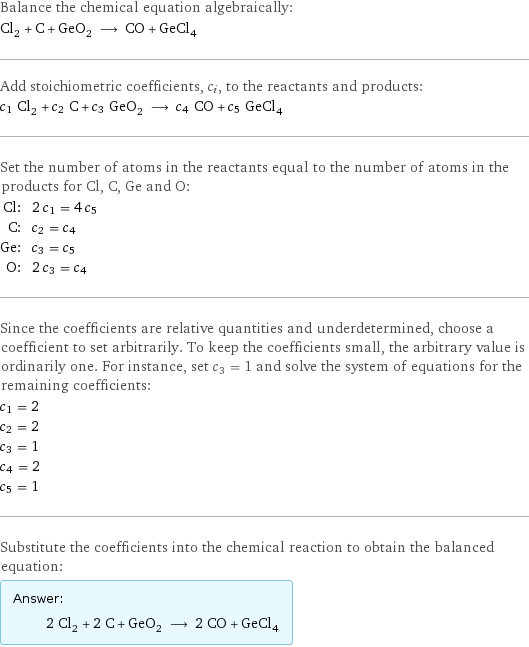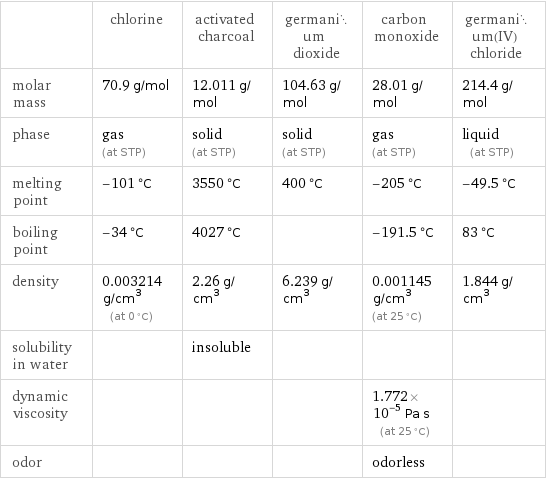Input interpretation

Cl_2 chlorine + C activated charcoal + GeO_2 germanium dioxide ⟶ CO carbon monoxide + GeCl_4 germanium(IV) chloride
Balanced equation

Balance the chemical equation algebraically: Cl_2 + C + GeO_2 ⟶ CO + GeCl_4 Add stoichiometric coefficients, c_i, to the reactants and products: c_1 Cl_2 + c_2 C + c_3 GeO_2 ⟶ c_4 CO + c_5 GeCl_4 Set the number of atoms in the reactants equal to the number of atoms in the products for Cl, C, Ge and O: Cl: | 2 c_1 = 4 c_5 C: | c_2 = c_4 Ge: | c_3 = c_5 O: | 2 c_3 = c_4 Since the coefficients are relative quantities and underdetermined, choose a coefficient to set arbitrarily. To keep the coefficients small, the arbitrary value is ordinarily one. For instance, set c_3 = 1 and solve the system of equations for the remaining coefficients: c_1 = 2 c_2 = 2 c_3 = 1 c_4 = 2 c_5 = 1 Substitute the coefficients into the chemical reaction to obtain the balanced equation: Answer: | | 2 Cl_2 + 2 C + GeO_2 ⟶ 2 CO + GeCl_4
Structures

+ + ⟶ +
Names

chlorine + activated charcoal + germanium dioxide ⟶ carbon monoxide + germanium(IV) chloride
Equilibrium constant
![Construct the equilibrium constant, K, expression for: Cl_2 + C + GeO_2 ⟶ CO + GeCl_4 Plan: • Balance the chemical equation. • Determine the stoichiometric numbers. • Assemble the activity expression for each chemical species. • Use the activity expressions to build the equilibrium constant expression. Write the balanced chemical equation: 2 Cl_2 + 2 C + GeO_2 ⟶ 2 CO + GeCl_4 Assign stoichiometric numbers, ν_i, using the stoichiometric coefficients, c_i, from the balanced chemical equation in the following manner: ν_i = -c_i for reactants and ν_i = c_i for products: chemical species | c_i | ν_i Cl_2 | 2 | -2 C | 2 | -2 GeO_2 | 1 | -1 CO | 2 | 2 GeCl_4 | 1 | 1 Assemble the activity expressions accounting for the state of matter and ν_i: chemical species | c_i | ν_i | activity expression Cl_2 | 2 | -2 | ([Cl2])^(-2) C | 2 | -2 | ([C])^(-2) GeO_2 | 1 | -1 | ([GeO2])^(-1) CO | 2 | 2 | ([CO])^2 GeCl_4 | 1 | 1 | [GeCl4] The equilibrium constant symbol in the concentration basis is: K_c Mulitply the activity expressions to arrive at the K_c expression: Answer: | | K_c = ([Cl2])^(-2) ([C])^(-2) ([GeO2])^(-1) ([CO])^2 [GeCl4] = (([CO])^2 [GeCl4])/(([Cl2])^2 ([C])^2 [GeO2])](../image_source/dfc1a7d815312cda2deeb513571fdb56.png)
Construct the equilibrium constant, K, expression for: Cl_2 + C + GeO_2 ⟶ CO + GeCl_4 Plan: • Balance the chemical equation. • Determine the stoichiometric numbers. • Assemble the activity expression for each chemical species. • Use the activity expressions to build the equilibrium constant expression. Write the balanced chemical equation: 2 Cl_2 + 2 C + GeO_2 ⟶ 2 CO + GeCl_4 Assign stoichiometric numbers, ν_i, using the stoichiometric coefficients, c_i, from the balanced chemical equation in the following manner: ν_i = -c_i for reactants and ν_i = c_i for products: chemical species | c_i | ν_i Cl_2 | 2 | -2 C | 2 | -2 GeO_2 | 1 | -1 CO | 2 | 2 GeCl_4 | 1 | 1 Assemble the activity expressions accounting for the state of matter and ν_i: chemical species | c_i | ν_i | activity expression Cl_2 | 2 | -2 | ([Cl2])^(-2) C | 2 | -2 | ([C])^(-2) GeO_2 | 1 | -1 | ([GeO2])^(-1) CO | 2 | 2 | ([CO])^2 GeCl_4 | 1 | 1 | [GeCl4] The equilibrium constant symbol in the concentration basis is: K_c Mulitply the activity expressions to arrive at the K_c expression: Answer: | | K_c = ([Cl2])^(-2) ([C])^(-2) ([GeO2])^(-1) ([CO])^2 [GeCl4] = (([CO])^2 [GeCl4])/(([Cl2])^2 ([C])^2 [GeO2])
Rate of reaction
![Construct the rate of reaction expression for: Cl_2 + C + GeO_2 ⟶ CO + GeCl_4 Plan: • Balance the chemical equation. • Determine the stoichiometric numbers. • Assemble the rate term for each chemical species. • Write the rate of reaction expression. Write the balanced chemical equation: 2 Cl_2 + 2 C + GeO_2 ⟶ 2 CO + GeCl_4 Assign stoichiometric numbers, ν_i, using the stoichiometric coefficients, c_i, from the balanced chemical equation in the following manner: ν_i = -c_i for reactants and ν_i = c_i for products: chemical species | c_i | ν_i Cl_2 | 2 | -2 C | 2 | -2 GeO_2 | 1 | -1 CO | 2 | 2 GeCl_4 | 1 | 1 The rate term for each chemical species, B_i, is 1/ν_i(Δ[B_i])/(Δt) where [B_i] is the amount concentration and t is time: chemical species | c_i | ν_i | rate term Cl_2 | 2 | -2 | -1/2 (Δ[Cl2])/(Δt) C | 2 | -2 | -1/2 (Δ[C])/(Δt) GeO_2 | 1 | -1 | -(Δ[GeO2])/(Δt) CO | 2 | 2 | 1/2 (Δ[CO])/(Δt) GeCl_4 | 1 | 1 | (Δ[GeCl4])/(Δt) (for infinitesimal rate of change, replace Δ with d) Set the rate terms equal to each other to arrive at the rate expression: Answer: | | rate = -1/2 (Δ[Cl2])/(Δt) = -1/2 (Δ[C])/(Δt) = -(Δ[GeO2])/(Δt) = 1/2 (Δ[CO])/(Δt) = (Δ[GeCl4])/(Δt) (assuming constant volume and no accumulation of intermediates or side products)](../image_source/ad77832f8a5224364672858c5054452b.png)
Construct the rate of reaction expression for: Cl_2 + C + GeO_2 ⟶ CO + GeCl_4 Plan: • Balance the chemical equation. • Determine the stoichiometric numbers. • Assemble the rate term for each chemical species. • Write the rate of reaction expression. Write the balanced chemical equation: 2 Cl_2 + 2 C + GeO_2 ⟶ 2 CO + GeCl_4 Assign stoichiometric numbers, ν_i, using the stoichiometric coefficients, c_i, from the balanced chemical equation in the following manner: ν_i = -c_i for reactants and ν_i = c_i for products: chemical species | c_i | ν_i Cl_2 | 2 | -2 C | 2 | -2 GeO_2 | 1 | -1 CO | 2 | 2 GeCl_4 | 1 | 1 The rate term for each chemical species, B_i, is 1/ν_i(Δ[B_i])/(Δt) where [B_i] is the amount concentration and t is time: chemical species | c_i | ν_i | rate term Cl_2 | 2 | -2 | -1/2 (Δ[Cl2])/(Δt) C | 2 | -2 | -1/2 (Δ[C])/(Δt) GeO_2 | 1 | -1 | -(Δ[GeO2])/(Δt) CO | 2 | 2 | 1/2 (Δ[CO])/(Δt) GeCl_4 | 1 | 1 | (Δ[GeCl4])/(Δt) (for infinitesimal rate of change, replace Δ with d) Set the rate terms equal to each other to arrive at the rate expression: Answer: | | rate = -1/2 (Δ[Cl2])/(Δt) = -1/2 (Δ[C])/(Δt) = -(Δ[GeO2])/(Δt) = 1/2 (Δ[CO])/(Δt) = (Δ[GeCl4])/(Δt) (assuming constant volume and no accumulation of intermediates or side products)
Chemical names and formulas

| chlorine | activated charcoal | germanium dioxide | carbon monoxide | germanium(IV) chloride formula | Cl_2 | C | GeO_2 | CO | GeCl_4 Hill formula | Cl_2 | C | GeO_2 | CO | Cl_4Ge name | chlorine | activated charcoal | germanium dioxide | carbon monoxide | germanium(IV) chloride IUPAC name | molecular chlorine | carbon | | carbon monoxide | tetrachlorogermane
Substance properties

| chlorine | activated charcoal | germanium dioxide | carbon monoxide | germanium(IV) chloride molar mass | 70.9 g/mol | 12.011 g/mol | 104.63 g/mol | 28.01 g/mol | 214.4 g/mol phase | gas (at STP) | solid (at STP) | solid (at STP) | gas (at STP) | liquid (at STP) melting point | -101 °C | 3550 °C | 400 °C | -205 °C | -49.5 °C boiling point | -34 °C | 4027 °C | | -191.5 °C | 83 °C density | 0.003214 g/cm^3 (at 0 °C) | 2.26 g/cm^3 | 6.239 g/cm^3 | 0.001145 g/cm^3 (at 25 °C) | 1.844 g/cm^3 solubility in water | | insoluble | | | dynamic viscosity | | | | 1.772×10^-5 Pa s (at 25 °C) | odor | | | | odorless |
Units
